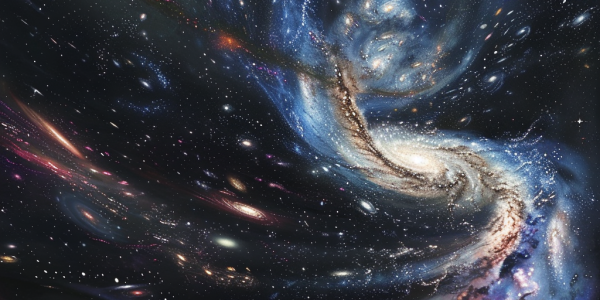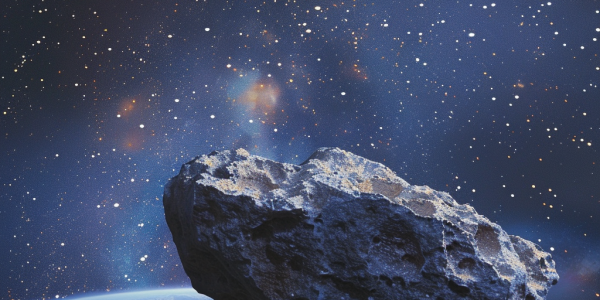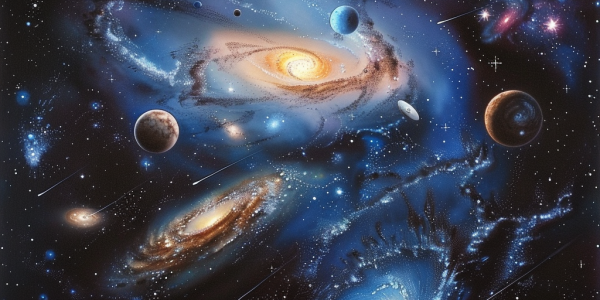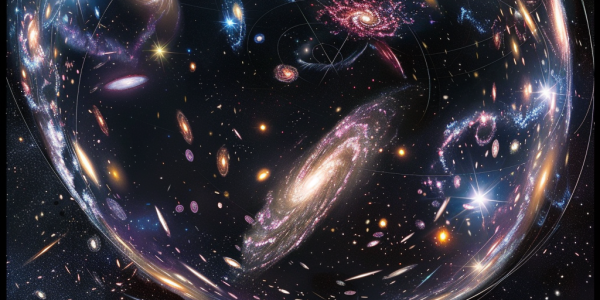New Hypothesis Suggests Massive Planet Influenced Solar System’s Orbital Configuration
Recent research suggests that a massive planet, potentially larger than Jupiter, may have influenced the orbits of our Solar System’s planets during its formative years. This new hypothesis challenges existing theories of planetary migration, proposing that an external force could explain the peculiar orbital characteristics of gas giants. As scientists explore this theory, they aim to uncover the complex dynamics that have shaped our Solar System and others in the galaxy.
New DESI Findings Challenge Understanding of Dark Energy and Universe’s Fate
Recent findings from the Dark Energy Spectroscopic Instrument (DESI) collaboration have reaffirmed Einstein’s general relativity while challenging our understanding of dark energy. With dark energy accounting for nearly 70% of the universe, new evidence suggests it may be weakening, raising profound questions about the universe’s future. As researchers explore these revelations, the implications could reshape cosmology and our comprehension of the cosmos.
NASA to Monitor Asteroid 2024 PT5’s Close Approach to Earth
NASA reports that asteroid 2024 PT5, a 33-foot fragment from the Moon, will closely approach Earth in January 2025. This event presents a unique opportunity for scientists to study the asteroid, which poses no threat to our planet. As it orbits at a distance nine times further than the Moon, astronomers are eager to monitor its trajectory, contributing to planetary defense efforts and enhancing our understanding of near-Earth objects.
The Challenge of Establishing Accurate Timekeeping on the Moon
As humanity prepares for a sustained presence on the Moon, researchers are tackling the challenge of accurate lunar timekeeping. Recent studies reveal that time on the Moon flows differently than on Earth, influenced by gravitational forces and Einstein’s Theory of Relativity. The White House has called for a lunar time standard to support future missions and bases, highlighting the importance of precise timekeeping for navigation and communication in space exploration. This initiative is crucial for NASA’s Artemis missions and future endeavors beyond Earth.
China Unveils World’s Most Advanced Hypergravity Facility in Hangzhou
China has inaugurated the Centrifugal Hypergravity and Interdisciplinary Experiment Facility (CHIEF) in Hangzhou, featuring the world’s most advanced hypergravity machine. This groundbreaking facility aims to simulate extreme gravitational conditions, enhancing research in engineering, aerospace, and biological systems. With capabilities to generate thousands of times Earth’s gravity, CHIEF is poised to revolutionize hypergravity studies and foster international scientific collaboration.
Exploring the Enigmas of Dark Matter and Dark Energy
Explore the mysteries of dark matter and dark energy, which together constitute about 95% of the universe’s mass-energy content. This article delves into the enigma of dark energy, the invisible nature of dark matter, and the ongoing search for dark matter particles, revealing their crucial roles in cosmic evolution and the universe’s accelerated expansion.
Discovery of ‘Missing Link’ Black Hole in Binary System G3425
A groundbreaking discovery of a stellar-mass black hole in the binary system G3425, located 5,800 light-years from Earth, has excited astronomers. This ‘missing link’ black hole, with a mass between 3.1 and 4.4 solar masses, challenges existing theories on black hole formation and evolution. The findings, published in Nature Astronomy, highlight the unique interplay between the red giant star and its dark companion, paving the way for further exploration of cosmic phenomena.
Astronomers Capture Stunning Images of ‘The Carousel Lens’ Gravitational Phenomenon
Astronomers have made a groundbreaking discovery with the gravitational lens known as ‘The Carousel Lens,’ captured by the Hubble Space Telescope. This rare cosmic alignment features seven distorted galaxies, providing unique insights into the early Universe and the complex nature of dark matter and dark energy. The Carousel Lens exemplifies the power of gravitational lensing in modern astronomy, offering a mesmerizing look into the cosmos and advancing our understanding of galactic formation and evolution.
NASA Confirms Existence of ‘Polar Wind’, an Invisible Force Stronger than Gravity
NASA has confirmed the existence of a powerful new force, dubbed ‘Polar Wind,’ which opposes gravity and is stronger than it. This groundbreaking discovery, stemming from decades of research, reveals that this invisible electric field causes atmospheric particles to leak into space, significantly enhancing our understanding of Earth’s dynamics. As scientists continue to explore this phenomenon, the implications for climate and future space exploration are profound.
New Study Challenges Understanding of Antikythera Mechanism
Discover the latest study revealing new insights into the Antikythera mechanism, an ancient device that continues to fascinate researchers. Learn how gravitational wave astronomy techniques challenge traditional views on the device’s calendar function, sparking debate among experts. Explore the implications of a proposed lunar calendar function and the differing opinions within the scholarly community.










